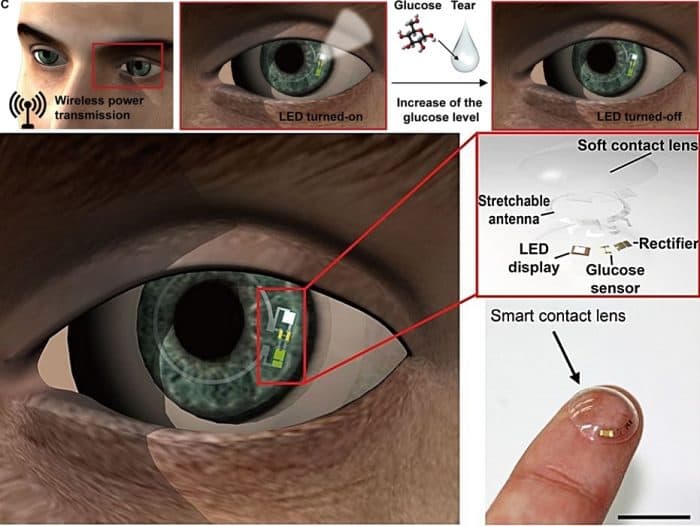Smart lens to detect Glucose level from teardrops
The modern trend of therapeutics shows a pile of health monitoring gadgets that to a certain degree reduces our need to visit a doctor every now and then. Be it glucose meter or a weight machine, these small yet efficient instruments guard our money and health. Though conspicuously available, a constant upgradation makes them more reliable, portable, effective and comparatively cheap. The UNIST affiliated research team consisting Professor Jang-Ung Park from the School of Materials Science and Engineering and Professor Franklin Bien from the School of Electrical and Computer Engineering at UNIST and Professor Jung Heon Lee from the School of Advanced Materials Science and Engineering at Sungkyunkwan University, has recently proposed a novel biosensing contact lens that can measure glucose level - a much needed aid for diabetes patients.

What did they do differently? the research team explains that the mere contact lens actually holds flexible and transparent electronics components that can measure Glucose level just by using tears in the eye. Unfortunately, the newest product could not be tested in human but it pictures a colorful future, gaining demands for its "no pain but gain" i.e. non-invasive nature. The only reason to frown is, failed attempts taken up by similar research prototypes. Due to poor wearability, those ideas could never materialize.
An enzyme based finger-pricking method is one of the most utilized glucose monitoring tools but with this upgradation, the instrument will be better accepted since it does not include blood in a direct manner. And to address wearability issues the research team innovated a smart contact lens that includes electrodes containing supremely stretchable and transparent materials with a glucose sensor which again transfers an electrical signal to a LED. Finally, this small bug in your eye will be able to transmit real-time information and analyze it using an embedded wireless antenna in the lens.
The prototype has been live tested on a rabbit via non-invasive in-vivo procedure and it did not show any sign of abnormality even after multiple blinks and the LED indicator turned-off just as the tear fluid with Glucose concentration crossed the threshold value. As a bonus, the lens, in fact, maintains the normal eye temperature even undergoing a wireless transmission.
Jihun Park, the first author, from the Combined M.S./Ph.D. of Materials Science and Engineering, has mentioned that the device does not obstruct the wearer's view since it is made of transparent nanomaterials. He also added since the wireless antenna is being used to read sensor information, no separate power source like the battery has been utilized. The official publication finally ended the report with a meaningful note which suggests we might be a step closer to achieve smart lens just like sci-fi movies.
Watch the graphical representation of this research:
Source: #-Link-Snipped-#

What did they do differently? the research team explains that the mere contact lens actually holds flexible and transparent electronics components that can measure Glucose level just by using tears in the eye. Unfortunately, the newest product could not be tested in human but it pictures a colorful future, gaining demands for its "no pain but gain" i.e. non-invasive nature. The only reason to frown is, failed attempts taken up by similar research prototypes. Due to poor wearability, those ideas could never materialize.
An enzyme based finger-pricking method is one of the most utilized glucose monitoring tools but with this upgradation, the instrument will be better accepted since it does not include blood in a direct manner. And to address wearability issues the research team innovated a smart contact lens that includes electrodes containing supremely stretchable and transparent materials with a glucose sensor which again transfers an electrical signal to a LED. Finally, this small bug in your eye will be able to transmit real-time information and analyze it using an embedded wireless antenna in the lens.
The prototype has been live tested on a rabbit via non-invasive in-vivo procedure and it did not show any sign of abnormality even after multiple blinks and the LED indicator turned-off just as the tear fluid with Glucose concentration crossed the threshold value. As a bonus, the lens, in fact, maintains the normal eye temperature even undergoing a wireless transmission.
Jihun Park, the first author, from the Combined M.S./Ph.D. of Materials Science and Engineering, has mentioned that the device does not obstruct the wearer's view since it is made of transparent nanomaterials. He also added since the wireless antenna is being used to read sensor information, no separate power source like the battery has been utilized. The official publication finally ended the report with a meaningful note which suggests we might be a step closer to achieve smart lens just like sci-fi movies.
Watch the graphical representation of this research:
Source: #-Link-Snipped-#
0
